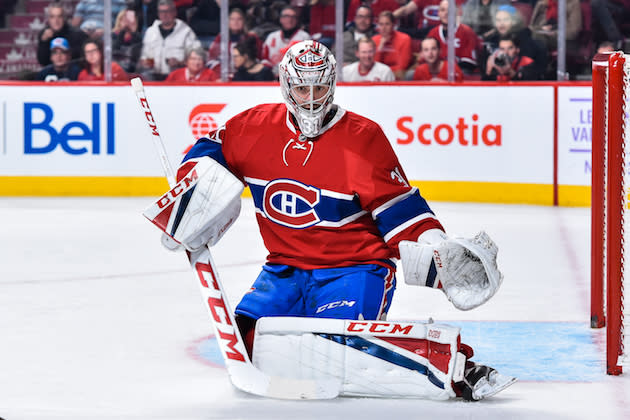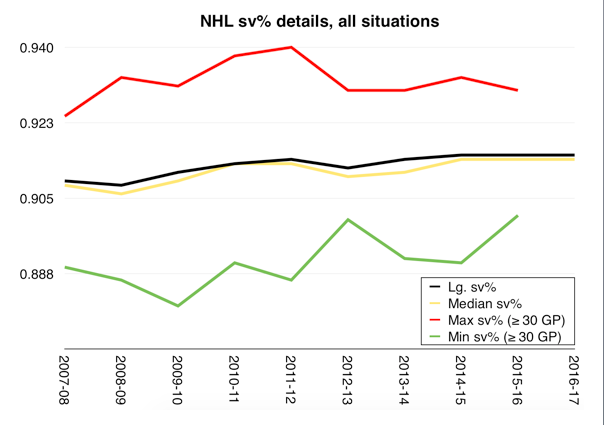What We Learned: Has the NHL reached 'peak goaltending?'

The NHL significantly changed its rules in the wake of the 2004-05 lockout as a means of engendering more goalscoring.
The effects were immediate: Lots more penalties in every game led to an increase of more than a goal a game, or half a goal per team. In the end, that means about 41 extra goals for every team over the course of the full season, on average.
But as any hockey fan is aware, the stringency of NHL officiating has declined ever since, and goalscoring slowly but surely crept back toward pre-shootout conditions. The league isn’t all the way there quite yet, with teams scoring about an extra tenth of a goal every game, but it’s pretty damn close.
Part of the reason for that is goaltending just keeps getting better, and offenses do as well. The average NHL team so far this season takes about 30 shots a game, and its goalies save about 27.4 of them. That gives you roughly a .915 save percentage across the entire NHL. It’s a far cry from pre-lockout averages, which tended to start in the nine-oh-blank range, and only once climbed to .911 (in 2003-04). Since then, it’s happened eight times, all in the past eight seasons.
Before 1983-84, the NHL didn’t officially track shots numbers, so no one could tell you what Terry Sawchuk’s career save percentage is. But we still have more than three decades of data to pull from, and right up until 1994-95, the league average had never started with a “9.” But now anyone with a save percentage beginning with an “8” might as well pack their bags for the Europe, because that’s simply not welcome in North America any more.
[Join a Yahoo Daily Fantasy Hockey contest now]
And because save percentages had been going up steadily for some time, people started freaking out. “Where does it end?” The answer, perhaps, is the current league-average save percentage of .915. It’s held steady there for the past three seasons, even as the number of shots goaltenders face every game is on the rise. The question therefore changes, from “Where does it end?” to “Has modern goaltending talent topped out?”
It’s exciting to live on the extremes of sport, to see what the human body can achieve if stretched to its logical limits. There was an article a few years ago about the point at which human beings will simply no longer be physiologically able to improve on the record time for completing a marathon or the top speed at which a pitcher can throw a fastball. One begins to wonder then if a sampling of, say, the 60 or so best goaltenders alive simply can’t stop more than roughly 91.5 percent of the shots they face without a radical change being made.
Because at this point we’re at three straight seasons of .915, and five of the past six have been either .914 or .915. The only exception was the lockout-shortened season in which goalies went a mere .912, but one imagines that with the extra 510 games lost, that number would have probably come up.
To figure out where goaltending stands at this point and how much better the average guy can get, we need to look at the Behind the Net era specifically, because goaltending seems to have become particularly frustrating for all involved around the time corsi started getting tracked in 2007-08. (It’s just a weird coincidence, don’t get mad that corsi is ruining another aspect of the sport!)
In all, goaltenders faced almost 650,000 shots during that period, and they stopped about 91.24 percent of them. The median save percentage in this group of almost 900 goalies who got at least one second of playing time during that time was .911. But what’s interesting is that over time, the extremes of great and league-worst goaltending performances seem to be converging as the average flatlines. I would also expect that to continue this season when 35 or so goalies start clearing 30 games.

I have some theories as to why this might be, including the larger shot volume goaltenders face and the fact that more goalies are coming up having trained with goaltending coaches at various developmental levels, rather than just as pros.
But regardless, the trend is clear: Over more than 40 or 50 games, it’s really hard to get north of .930, and most elite goaltenders are in the low- to mid-.920s range. But as the league filters out lower-end goaltenders, the league average might creep up slightly. That’s also true as two new goalies get NHL jobs with Vegas coming into the league next year, because that just means the Nos. 61 and 62 goalies in the world are now NHLers as well. More expansion teams in the future will only mean more guys get through the door as well.
If the elite goalies of the past several years are regularly .920-plus and that’s it, I wonder if you can expect that the average can creep up much higher than .915. That’s a number that even a decade ago would have gotten you plenty of plaudits, but it’s so common now as to be unremarkable.
[Follow Puck Daddy on Facebook]
Unless the league does something crazy like significantly shrink the pads (an issue to which goalies will adjust after about a season), or make the nets bigger (god forbid), it seems to me that .915 is about where we’re maxing out. Up or down from there one year to the next, sure, but this appears to be the modern baseline.
What We Learned
Anaheim Ducks: The Ducks are 0-5 in OT and the shootout. I bet that doesn’t come back to haunt them at all at the end of the year.
Arizona Coyotes: Hmm this makes sense. Wait, MIKE Smith? The BLUE JACKETS? No never mind.
Boston Bruins: Now Tuukka Rask stopping 35 of 36 against Buffalo? THAT makes sense.
Buffalo Sabres: Woof, is Buffalo becoming one of those places where the other team’s fans make a whole big racket? They only have two sellouts this year.
Calgary Flames: The Flames keep winning because they stopped managing their defense incorrectly. Funny how that works.
Carolina Hurricanes: Man, imagine if all these high-level young forwards work out in a year or two? This team is going to be good.
Chicago: These are always such great little stories.
Colorado Avalanche: Erik Johnson being out six to eight weeks is exactly what this club needs just kidding.
Columbus Blue Jackets: When you get 60 shots on goal and your goalie’s like “I just wanted to give the guys a chance to win,” that is extremely weird.
Dallas Stars: Hey, the Stars actually won and did everything right. They’re still only 10-10-6.
Detroit Red Wings: The only thing more watchable than this Red Wings team is this Red Wings team after a bunch of injuries.
Edmonton Oilers: Man, maybe these Oilers are just a decent team after all.
Florida Panthers: Ah jeez. Not encouraging.
Los Angeles Kings: Teddy Purcell has long been one of those guys the underlying numbers love. That’s not the case anymore, and that’s why he got waived.
Minnesota Wild: Alex Stalock just seems like a good, solid backup at this point.
Montreal Canadiens: It would be hilarious if they traded Subban to satisfy Max Pacioretty, and then traded Pacioretty a year later.
Nashville Predators: The Preds had a great November. Now they have to hope Pekka Rinne can keep stopping 93 percent of the shots he faces.
New Jersey Devils: Of course, it’s hard to keep playing well when you’re blowing 4-1 leads to the Devils.
New York Rangers: The Rangers don’t have a win when scoring two goals or fewer, meaning Lundqvist hasn’t “stolen” a game for them. What a bum. Trade him to Dallas.
Ottawa Senators: Mike Condon? Strong play? That can’t be right.
Philadelphia Flyers: Jakub Voracek on the Flyers fans’ new tradition of yelling “woo” after the Flyers score: “It’s childish and annoying and it’s really starting to piss me off. The first period they are (bleeping) wooing. What are you? (Bleeping) 10 years old?” Hope they keep it up all over.
Pittsburgh Penguins: It really does seem like even if Pittsburgh doesn’t play well, they still win a lot of 5-3 games.
San Jose Sharks: Brent Burns thinks Martin Jones is elite. I wouldn’t go that far, but he’s quite good.
St. Louis Blues: Oh yeah, remember Jori Lehtera?
Tampa Bay Lightning: Ben Bishop playing well would be good news for both him and the team. They could all use the Ws, but they could also use a tradeable goaltender playing well.
Toronto Maple Leafs: Losing to Vancouver is bad. Don’t do that.
Vancouver Canucks: I love when the media for some bad team gets itself all hyped up for a blood feud and then the game has like one fight and that’s it. It’s almost like all this violent drama is manufactured BS. Weird.
Vegas Golden Knights: Good lord, even if the Kings expose Dustin Brown, Vegas shouldn’t actually take him. Even if the Kings could have retained some of his salary, which they can’t.
Washington Capitals: When even the Capitals aren’t scoring, that’s just weird. That’s what they’re good for.
Winnipeg Jets: Seems like getting Brian Little back has been quite helpful for the Jets.
Play of the Weekend
This is an amazing goal that was only a little bit offside.
An overtime goal doesn't get much better than this. #PROvsSPR pic.twitter.com/HIql2fVwvk
— AHL (@TheAHL) December 4, 2016
Gold Star Award

I guess you gotta give this one to Mike Smith even though he lost.
Minus of the Weekend

You probably shouldn’t blow a 4-1 lead. That is just my opinion.
Perfect HFBoards Trade Proposal of the Week
User “Captain Controversy” is living up to his name.
Matt Duchene + Tyson Barrie + jarome Iginla
For
Ryan Nugent Hopkins + 2017 First round pick + Andre Sekere (assuming he waives NTC)
Signoff
Where’s my elephant?
Ryan Lambert is a Puck Daddy columnist. His email is here and his Twitter is here.
MORE FROM YAHOO HOCKEY:

 Yahoo Sports
Yahoo Sports 

